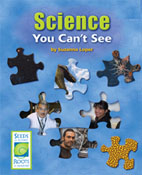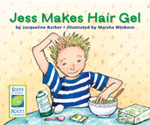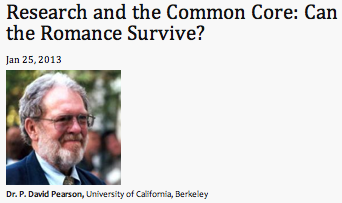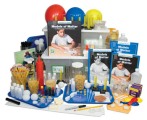Archive for January, 2013
How Can Students Study Things That Can’t be Seen? Using Evidence to Make Inferences.
 It is common to have students make inferences based on their observations when working in the lab or hands-on science classroom setting. What happens when ice is exposed to heat? What do you see when certain ingredients are added to mixtures? Can you see ink separate during chromatography?
It is common to have students make inferences based on their observations when working in the lab or hands-on science classroom setting. What happens when ice is exposed to heat? What do you see when certain ingredients are added to mixtures? Can you see ink separate during chromatography?
What if a phenomenon cannot be observed directly?
In the Seeds of Science/Roots of Reading® student book Science You Can’t See, students are introduced to the work of three scientists, each of whom studies a phenomenon that cannot be observed directly. Karen Chin studies dinosaurs, Edward Saade investigates the ocean floor, and Farid El Gabaly uses an electron microscope to make images of magnetic atoms. In order to answer their questions, these scientists must make inferences based on evidence. The book also highlights the ways that using models can help scientists make accurate inferences.
Starting with Karen Chin’s study of dinosaurs, the book explains how scientists can use fossils to try to answer questions about dinosaurs. Karen asked: How and what did dinosaurs eat? Though the dinosaurs are gone and they cannot be observed eating, Karen can studied coprolites, which are fossil droppings. Inside the droppings were bits of the plants and animals that dinosaurs ate. From this evidence, (more…)
Webinar Series Offers Educators Expert Feedback About Common Core State Standards
UPDATE – If you were not able to attend this webinar, the presentation slides are now available. Follow this link to download the PDF (2.4MB) – http://bit.ly/118FDOL
TextProject.org is presenting a series of live webinars on the Common Core State Standards. TextProject is a non-profit corporation founded in 2010 in the state of California. It formalizes a decade-plus of ongoing work by its founder, president and CEO Elfrieda H. (Freddy) Hiebert, to bring beginning and struggling readers to high levels of literacy through a variety of strategies and tools, particularly the texts used for reading instruction.
The first webinar, Research and the Common Core: Can the Romance Survive? considers the research foundations of the Common Core State Standards, especially as it pertains to comprehension. P. David Pearson, a faculty member at the Graduate School of Education at the University of California Berkeley and co-principal investigator for Seeds of Science/Roots of Reading, begins with the research underlying the Standards themselves and then considers the research evidence underlying content of follow-up documents such as the Publisher’s Criteria (produced by CCSS writers). Pearson then describes defensible positions which educators can take in keeping policies and practices grounded in the Standards themselves and not in supplementary recommendations that did not go through the rigorous review of the Standards themselves.
Webinar details
Date: Jan 25, 2013
Time: 12noon—1pm PST
Registration: Space is limited. https://www4.gotomeeting.com/register/240432031
Find out more about TextProject’s CCSS webinar series at http://textproject.org/events/common-core-state-standards-webinar-series/
Help Students Model the Steps of the Design Process by Making Hair Gel
 In the Seeds of Science/Roots of Reading student book, Jess Makes Hair Gel, students read an account of a boy who sets out to make his own hair gel. Through the book, students have an opportunity to see the design process in action, complete with obstacles, missteps, and successes that Jess encounters.
In the Seeds of Science/Roots of Reading student book, Jess Makes Hair Gel, students read an account of a boy who sets out to make his own hair gel. Through the book, students have an opportunity to see the design process in action, complete with obstacles, missteps, and successes that Jess encounters.
Students learn:
- there are important steps that scientists follow when they design something
- while each step is important, you don’t always need to follow the same exact steps, in the same exact order
- scientists often need to revise their plans as they go along, based on what they learn
In the book, Jess identifies the properties of a good hair gel and then tests different ingredients to see which have these properties. While conducting tests on each ingredient, Jess realizes that he needs to expand the list of properties of good hair gel to include several more. With this realization he is able to solve problems he encounters and end up with a great hair gel.
You can let your students design their own gels. Ask which ingredients they’d like to investigate. Take this opportunity to teach students to use the word substances. Explain that substance is a word scientists use for ingredient. Possible ingredient choices could include: shampoo, shaving cream, egg whites, corn syrup, gelatin and a glue stick (remind students to check with parents to determine the safety of an ingredient).
Share the important steps for designing mixtures.
- Decide on the properties you want your new mixture to have. (more…)
Celebrate Earth’s Rotation Day with Students
Earth’s Rotation Day is January 8th! Recognition of this day is a great way to incorporate a lesson on gravity.
 First, explain to students the importance of this day. On January 8, 1851, physicist Leon Foucault (foo-koh) demonstrated that the Earth rotates on its axis. The device he used to prove this is known as the Foucault’s Pendulum.
First, explain to students the importance of this day. On January 8, 1851, physicist Leon Foucault (foo-koh) demonstrated that the Earth rotates on its axis. The device he used to prove this is known as the Foucault’s Pendulum.
Without any formal scientific training, Foucault had an insight that no scientist before him had figured out. Check out this video that explains how the discovery became a rotation meter.
The pendulum swings freely to and fro under the action of gravity. Once set in motion, it continues to swing back and forth in a vertical plane defined by the track of the ball and cable. Although gravity is pulling down on the ball and tension in the cable is holding it up, there is no force acting to change the direction of swing. Air friction and gravity would eventually stop the pendulum from swinging, but a magnet encircling the cable pulls on the cable with each swing. Electric current controlling the magnetism is turned on and off with each swing of the pendulum.
 Here’s a nice segue to covering the topic of gravity with students. How does gravity affect their everyday life? In the Seeds of Science/Roots of Reading student book Gravity Is Everywhere, students are told they can’t escape gravity. Gravity is a pulling force. Earth pulls on them and everything around them with the force of gravity.
Here’s a nice segue to covering the topic of gravity with students. How does gravity affect their everyday life? In the Seeds of Science/Roots of Reading student book Gravity Is Everywhere, students are told they can’t escape gravity. Gravity is a pulling force. Earth pulls on them and everything around them with the force of gravity.
In the book, students learn that you can measure gravity. Simply measure your weight on a scale to measure the pull of gravity between you and Earth. The stronger the pull, the higher the number will be on a scale. Here’s a fun way to reinforce this concept with students. Show students the objects on the left side of this table and ask them to put in order the objects being pulled most strongly to Earth – from least to greatest. Then reveal the right side which details the weight. Ask them to report on whether their assumptions were correct.
In addition to the concept of measuring gravity, students also learn about gravity in space. Students will find it interesting to learn that if they visited another planet, their weight would be different there. One fun fact to astound them with is what a kid might weigh on the Sun…1,680 pounds! They would weigh about the same on Venus where the gravitational pull is similar to Earth’s. Key science vocabulary covered in Gravity is Everywhere includes: attract, compare, escape, force, gravity, Jupiter, Mars, measure, object, planet, Solar System, table, Universe, Venus and weight.
We hope you have fun celebrating Earth’s Rotation Day! It’s a great excuse to share engaging science concepts with your students.
For more information about the student book Gravity Is Everywhere and the Gravity and Magnetism science and literacy unit, visit http://www.wirelessgeneration.com/curriculum-instruction/seeds-of-science/overview.
Do you want to be notified when we publish new blog articles? Simply enter your email address in the “Follow Blog via Email” box located in the right sidebar.






